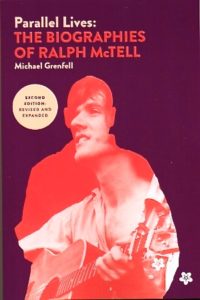Preface to the Second Edition

A second edition of a book is a wonderful opportunity to reconsider it from the vantage point that time necessarily provides once any piece of work has been released into the world. Further thoughts about the form and content of Parallel Lives have emerged since its original writing so that I now also have the advantage of feedback from those who have read it. Although this second edition remains true to the first, I have been able to revise, extend and amend the text in the light of reaction – my own and others.
As I wrote in the Foreword to the first edition, the book grew out of an interest in the processes of artistic creation and the place that biography – the artist’s and others – played in it. Biography is a hazardous and delicate literary form and the subject of my writing – Ralph McTell – had already been subject to his own and others writers’ accounts of his life and work. I did not want to repeat these approaches, nor could I. And, it seemed to me that all sorts of other ways might be adopted to consider any artist and their work. The book then became an exercise in seeing what happens when a selection of these approaches was taken to Ralph’s work, and the effect that these might have on the reader, not least Ralph himself.
Even in first writings for the book, I could already hear the cries of outrage when one takes an ‘analytical scalpel’ to a much loved and cherished body of work: Some readers have asserted that ‘it is all in the music’ and that the rest can be passed over without comment – or even being read! Anticipating such a response, I set out to have, at the core of the book, an affectionate discussion of Ralph’s work, supported by his own reflections of the various songs and the settings that gave rise to them. These parts of the book have been interspersed with a series of ‘interludes’ that explore the nature of creativity itself from diverse disciplines. None of these are particularly esoteric: Most of the books cited in these sections could be acquired at little cost from a twenty minutes visit to an online bookshop. In thinking about Ralph and his work, the choice of disciplines was, of course, my own and therefore necessarily reflected my own biography – intellectual in this case.
There is a scholarly tradition in the consideration of any piece of art – painting, writing, music, etc. – that juxtaposes ‘internal’ and ‘external’ accounts of it. The ‘internal’ takes art on its own terms, usually as a result of individual talent. In contrast, the ‘external’ reading sees an artwork as set within movements and developments established by recognized authorities – critics, historians and academics. Both clearly have limitations: the first, by seeing art as some sort of transcendent other; the second, by the orthodoxies imposed on it from outside of its own exegesis. If there is an oppositional tension between these two, and there is, this book in its way, aims to respect both whilst going beyond them. This is clearly a dangerous pursuit, since the ‘internalists’’ question “how I dare to analyze Ralph and his music?”, while the ‘externalists’ ask “why do I not conform to conventional disciplinary forms?”
I also employed various authorial tactics to de-centre the narrative, and to elude the misappropriation of another’s biography for goals – scholastic, journalistic or otherwise – of my own. In its way, the book seeks to break away from predetermined accounts of the experience of art and aesthetics – for the artist and their audience. In my conclusion to the original version, I noted that many others elements emerged along the way in writing the book, not least aspects of my own biography, the effects of memory and the interpretation I give and gave to the music of my life. I return to these issues in the new Afterword section.
This book is my first attempt to integrate a range of sources into a single narrative. It is a ‘working-out’ of a methodology, and a ‘putting-together’ of disparate sources, so that they can now be applied to other areas of popular culture. In preparing this second edition, I have aimed to set all these aspects of the book in sharper relief.
See author interview: https://youtu.be/P_p9OtekKUE
Price: 14.99 GBP
Shipping: 2.80 GBP
As well as being revised and expanded, this Second Edition is in larger format with new cover and graphics.
Order through Amazon or cheque made payable to M. Grenfell at Pomera Press:
E-Book currently being prepared: Available Fall 2020
ISBN 978-0-9935670-1-8
Pomera Press: http://www.pomera.co.uk/books/parallel_lives_second_edition/
Pomera Press, PO Box 401
Lyndhurst SO4OOGG
UK
Contents
Introduction
Ralph McTell – Empirical Biography
Elements of Methodology – Constructing the Aesthetic and its Representation
Biography at Work I – Life and Work
Creativity Interludes
Creative Interlude I – Aesthetics (Philosophy/ Sociology)
Biography at Work II – Work and Life
Creativity Interlude III – Psychology
Biography at Work III – Another World Coming Through
– The Boy with a Note
– The Blues
Field Conditions
Creativity Interlude III – Spiritual
Fields within Fields
– The General Conditions in Britain in 1940s, 50s, 60s
– The Folk Revivals and the Fields of Power
Conclusion
References
Ralph McTell – Recordings Consulted